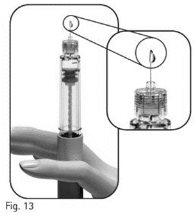
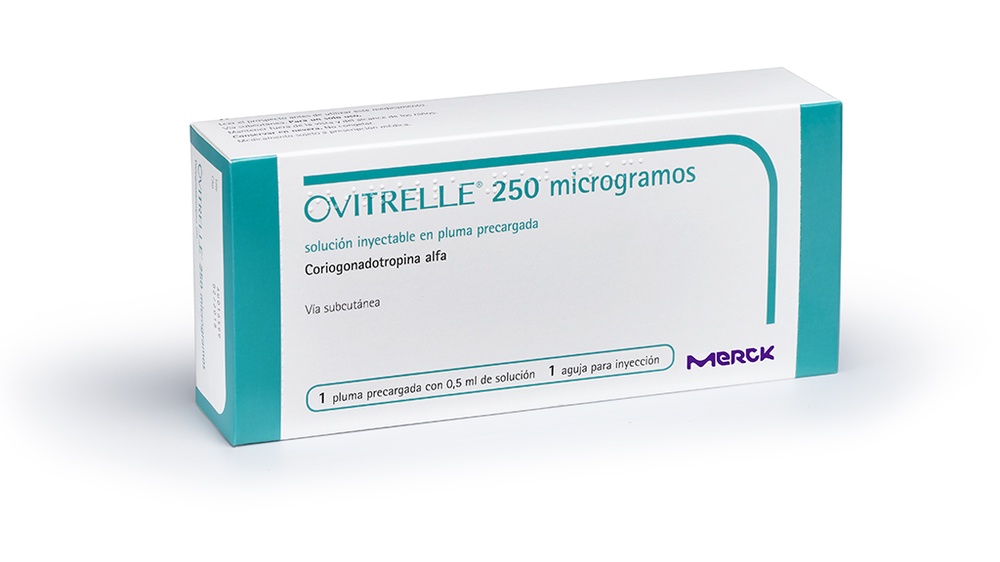
ОВИТРЕЛЛЕ 250 микрограмм раствор для инъекций в предзаполненной шприц-ручке


Инструкция по применению ОВИТРЕЛЛЕ 250 микрограмм раствор для инъекций в предзаполненной шприц-ручке
Введение
Инструкция: информация для пользователя
Овитрелле 250микрограммов раствор для инъекций в предварительно заполненном шприце
кориогонадотропин альфа
Прочитайте внимательно всю инструкцию перед началом использования этого лекарства, поскольку она содержит важную информацию для вас.
- Сохраните эту инструкцию, поскольку вам может потребоваться прочитать ее снова.
- Если у вас есть какие-либо вопросы, проконсультируйтесь с вашим врачом или фармацевтом.
- Это лекарство было назначено только вам, и не передавайте его другим людям, даже если у них такие же симптомы, как у вас, поскольку оно может нанести им вред.
- Если вы испытываете побочные эффекты, проконсультируйтесь с вашим врачом или фармацевтом, даже если это побочные эффекты, которые не перечислены в этой инструкции. См. раздел 4.
Содержание инструкции:
- Что такое Овитрелле и для чего оно используется
- Что вам нужно знать перед началом использования Овитрелле
- Как использовать Овитрелле
- Возможные побочные эффекты
- Хранение Овитрелле
- Содержание упаковки и дополнительная информация
1. Что такое Овитрелле и для чего оно используется
Что такое Овитрелле
Овитрелле содержит лекарство под названием "кориогонадотропин альфа", изготовленное в лаборатории с помощью специальной техники рекомбинантной ДНК. Коригонадотропин альфа подобен гормону, который находится в вашем организме естественным образом, называемому "гонадотропином хорионическим", который участвует в репродукции и фертильности.
Для чего используется Овитрелле
Овитрелле используется вместе с другими лекарствами:
- Чтобы помочь развиться и созреть несколько фолликулов (каждый из которых содержит яйцеклетку) у женщин, подвергающихся вспомогательным репродуктивным технологиям (процедуре, которая может помочь вам забеременеть), таким как "экстракорпоральное оплодотворение". Сначала будут назначены другие лекарства для стимуляции роста нескольких фолликулов.
- Чтобы помочь освободить яйцеклетку из яичника (индукция овуляции) у женщин, которые не могут производить яйцеклетки ("ановаруляция") или производят очень мало ("олиговаруляция"). Сначала будут назначены другие лекарства для развития и созревания фолликулов.
2. Что вам нужно знать перед началом использования Овитрелле
Не используйте Овитрелле
- если вы аллергичны к кориогонадотропину альфа или к любому другому компоненту этого лекарства (перечисленному в разделе 6),
- если у вас есть опухоль в гипоталамусе или гипофизе (обе части мозга),
- если у вас есть большие яичники или большие жидкостные образования внутри яичников (овариальные кисты) неизвестного происхождения,
- если у вас есть вагинальные кровотечения неизвестной причины,
- если у вас есть рак яичников, матки или молочной железы,
- если вы страдаете тяжелой воспалением вен или тромбами в венах (активные тромбоэмболические осложнения),
- если у вас есть обстоятельства, которые обычно препятствуют нормальной беременности, такие как менопауза или преждевременная менопауза (овариальная недостаточность), или аномалии половых органов.
Не используйте Овитрелле, если любое из вышеуказанных условий выполнено. Если вы не уверены, проконсультируйтесь с вашим врачом перед приемом этого лекарства.
Предостережения и меры предосторожности
Перед началом лечения ваша фертильность и фертильность вашего партнера должны быть оценены врачом, специализирующимся на лечении проблем фертильности.
Синдром гиперстимуляции яичников (СГЯ)
Это лекарство может увеличить риск развития СГЯ. Это происходит, когда фолликулы развиваются слишком сильно и превращаются в большие кисты.
Если вы заметили боль в нижней части живота, быстро набираете вес, испытываете тошноту или рвоту, или испытываете трудности с дыханием, не вводите инъекцию Овитрелле и немедленно проконсультируйтесь с вашим врачом (см. раздел 4). Если вы развили СГЯ, вам может быть рекомендовано воздержаться от половых контактов или использовать барьерный метод контрацепции не менее четырех дней.
Риск СГЯ снижается, если используется обычная доза Овитрелле и если вы тщательно контролируете на протяжении всего цикла лечения (например, с помощью анализов крови для измерения уровня эстрадиола и ультразвукового исследования).
Многоплодная беременность и/или врожденные аномалии
Во время использования Овитрелле у вас повышен риск многоплодной беременности (обычно двойни) по сравнению с естественным зачатием. Многоплодная беременность может привести к осложнениям для вас и вашего ребенка. Во время лечения вспомогательными репродуктивными технологиями риск многоплодной беременности связан с вашим возрастом и качеством, а также количеством оплодотворенных яйцеклеток или эмбрионов, которые будут имплантированы в ваш организм. Многоплодные беременности и определенные характеристики пар с проблемами фертильности (например, возраст) также могут быть связаны с повышенным риском врожденных аномалий.
Риск многоплодной беременности снижается, если вы тщательно контролируете на протяжении всего цикла лечения (например, с помощью анализов крови для измерения уровня эстрадиола и ультразвукового исследования).
Внематочная беременность
Может произойти беременность вне матки (внематочная беременность) у женщин с повреждением фаллопиевых труб (протоков, которые переносят яйцеклетку из яичника в матку). Поэтому ваш врач должен провести раннее ультразвуковое исследование, чтобы исключить возможность беременности вне матки.
Аборт
Во время лечения вспомогательными репродуктивными технологиями или стимуляции ваших яичников для производства яйцеклеток у вас повышен риск аборта по сравнению со средним показателем для женщин.
Проблемы с свертываемостью крови (тромбоэмболические эпизоды)
Проконсультируйтесь с вашим врачом перед использованием Овитрелле, если вы или члены вашей семьи имели когда-либо тромбы в ноге или легких, или инфаркт миокарда или инсульт. Вы можете иметь повышенный риск тяжелых тромбов или ухудшения существующих тромбов при приеме Овитрелле.
Опухоли половых органов
Были зарегистрированы опухоли яичников и других половых органов, как доброкачественные, так и злокачественные, у женщин, получавших различные лекарственные препараты для лечения бесплодия.
Тесты на беременность
Если вы проведете тест на беременность с помощью сыворотки или мочи после использования Овитрелле и в течение десяти дней после этого, может произойти ложноположительный результат. Если вы не уверены, проконсультируйтесь с вашим врачом.
Дети и подростки
Овитрелле не должен использоваться у детей и подростков.
Другие лекарства и Овитрелле
Сообщите вашему врачу, если вы используете, недавно использовали или можете использовать любое другое лекарство.
Беременность и лактация
Не используйте Овитрелле, если вы беременны или в период лактации.
Если вы беременны или в период лактации, проконсультируйтесь с вашим врачом перед использованием этого лекарства.
Вождение и использование машин
Не ожидается, что Овитрелле повлияет на вашу способность управлять транспортными средствами или работать с машинами.
Овитрелле содержит натрий
Это лекарство содержит менее 1 ммоль натрия (23 мг) на дозу; это означает, что оно практически "не содержит натрия".
3. Как использовать Овитрелле
Следуйте точно инструкциям по введению этого лекарства, указанным вашим врачом. В случае сомнений проконсультируйтесь с вашим врачом или фармацевтом.
Какое количество использовать
- Рекомендуемая доза Овитрелле составляет 1 предварительно заполненный шприц (250 микрограммов/0,5 мл) в виде единственной инъекции.
- Ваш врач объяснит вам точно, когда необходимо сделать инъекцию.
Использование этого лекарства
- Если вы будете вводить Овитрелле самостоятельно, внимательно прочитайте и следуйте "Инструкциям по использованию".
- Овитрелле вводится в виде подкожной инъекции.
- Каждый предварительно заполненный шприц предназначен для одноразового использования.
- Ваш врач или медсестра научат вас, как использовать предварительно заполненный шприц Овитрелле для введения лекарства.
- Вводите Овитрелле так, как вам показал ваш врач или медсестра.
- После инъекции безопасно утилизируйте использованную иглу и утилизируйте шприц.
Если вы использовали больше Овитрелле, чем следует
Эффекты передозировки Овитрелле неизвестны; однако, существует возможность развития синдрома гиперстимуляции яичников (СГЯ), который более подробно описан в разделе 4.
Если вы пропустили использование Овитрелле
Если вы пропустили использование Овитрелле, свяжитесь с вашим врачом как можно скорее.
Если у вас есть какие-либо другие вопросы об использовании этого лекарства, проконсультируйтесь с вашим врачом или фармацевтом.
4. Возможные побочные эффекты
Как и все лекарства, это лекарство может вызывать побочные эффекты, хотя не все люди испытывают их.
Если вы заметили любой из следующих серьезных побочных эффектов, прекратите использование Овитрелле и немедленно проконсультируйтесь с врачом, поскольку вам может потребоваться срочная медицинская помощь:
- Аллергические реакции, такие как сыпь, учащенное или нерегулярное сердцебиение, отек языка или горла, чихание, свистящее дыхание или тяжелая дыхательная недостаточность, очень редки (могут поражать до 1 из 10 000 человек).
- Боль в нижней части живота, вздутие живота или абдоминальный дискомфорт, сопровождающиеся тошнотой (желанием рвоты) или рвотой, могут быть симптомами синдрома гиперстимуляции яичников (СГЯ). Это может указывать на то, что яичники слишком сильно реагируют на лечение и развиваются большие овариальные кисты (см. также в разделе 2 под "Синдром гиперстимуляции яичников"). Эти эпизоды часто встречаются (могут поражать до 1 из 10 человек).
- СГЯ может стать тяжелым с явным увеличением яичников, снижением производства мочи, набором веса, затруднением дыхания и возможным накоплением жидкости в желудке или груди. Эти эпизоды редки (могут поражать до 1 из 100 человек).
- Тяжелые тромбоэмболические осложнения, иногда независимые от СГЯ, очень редко встречаются. Они могут вызвать боль в груди, одышку, инсульт или инфаркт миокарда (см. также в разделе 2 под "Проблемы с свертываемостью крови").
Другие побочные эффекты
Частые (могут поражать до 1 из 10 человек)
- Головная боль.
- Местные реакции в месте инъекции, такие как боль, покраснение или отек.
Редкие (могут поражать до 1 из 100 человек)
- Диарея.
Сообщение о побочных эффектах
Если вы испытываете любой побочный эффект, проконсультируйтесь с вашим врачом или фармацевтом, даже если это побочные эффекты, которые не перечислены в этой инструкции. Вы также можете сообщить о них напрямую через систему фармаковигиланса: www.notificaRAM.es. Сообщая о побочных эффектах, вы можете внести свой вклад в предоставление более полной информации о безопасности этого лекарства.
5. Хранение Овитрелле
Храните это лекарство в недоступном для детей месте.
Не используйте это лекарство после истечения срока годности, указанного на этикетке и упаковке после "Срок годности". Срок годности - последний день месяца, указанного.
Храните в холодильнике (при температуре между 2°C и 8°C). Не замораживайте.
Не используйте Овитрелле, если вы заметили видимые признаки повреждения, если жидкость содержит частицы или не является прозрачной.
Лекарства не должны выбрасываться в канализацию или мусор. Спросите вашего фармацевта, как утилизировать упаковку и лекарства, которые вам больше не нужны. Таким образом, вы поможете защитить окружающую среду.
6. Содержимое упаковки и дополнительная информация
Состав Овитрелле
- Активное вещество - кориогонадотропин альфа, произведенный с помощью технологии рекомбинантной ДНК.
- Каждая предзагруженная ручка содержит 250 микрограммов кориогонадотропина альфа в 0,5 мл (что эквивалентно примерно 6 500 Международным единицам, МЕ).
- Другие компоненты - маннитол, метионин, дигидrogenфосфат динатрия дигидрат, дигидrogenфосфат натрия моногидрат, полоксамер 188, фосфорная кислота (для коррекции pH), гидроксид натрия (для коррекции pH) и вода для инъекционных препаратов.
Внешний вид продукта и содержимое упаковки
- Овитрелле выпускается в виде прозрачной, бесцветной или слегка желтоватой жидкости для инъекций в предзагруженной ручке.
- Каждая ручка содержит 0,5 мл раствора.
- Препарат поставляется в упаковках по 1 предзагруженной ручке и 2 иглам для инъекций (одна из них запасная).
Владелец разрешения на маркетинг
Merck Europe B.V., Gustav Mahlerplein 102, 1082 MA Amsterdam, Нидерланды
Производитель
Merck Serono S.p.A., Via delle Magnolie 15, 70026 Modugno (Bari), Италия.
Дата последнего пересмотра этой инструкции:05/2025.
Подробная информация о этом лекарственном средстве доступна на сайте Европейского агентства по лекарственным средствам: http://www.ema.europa.eu.
ИНСТРУКЦИИ ПО ПРИМЕНЕНИЮ
Овитрелле 250микрограммов
Инъекционный раствор в предзагруженной ручке
Кориогонадотропин альфа
Важная информация о предзагруженной ручке Овитрелле
- Прочитайте инструкции по применению и листок-вкладыш перед использованием предзагруженной ручки Овитрелле.
- Всегда следуйте всем указаниям этих инструкций по применению и обучению, которое предоставил медицинский работник, поскольку они могут отличаться от тех, которые вы получали ранее. Эта информация позволит избежать ошибок в лечении или инфекций, вызванных уколом иглы или травмами от разбитого стекла.
- Предзагруженная ручка Овитрелле предназначена только для подкожного введения.
- Предзагруженная ручка Овитрелле предназначена для одноразового использования.
- Каждая упаковка предзагруженной ручки Овитрелле содержит иглу для инъекции и запасную иглу.
- Используйте предзагруженную ручку Овитрелле только в том случае, если медицинский работник научил вас правильно ей пользоваться.
- Храните в холодильнике.
Незамораживайте.
Неделитесь ручкой или иглами с другими людьми.
Неиспользуйте предзагруженную ручку Овитрелле, если она упала или если ручка треснута или повреждена, поскольку это может вызвать травму.
Ознакомьтесь с предзагруженной ручкой Овитрелле
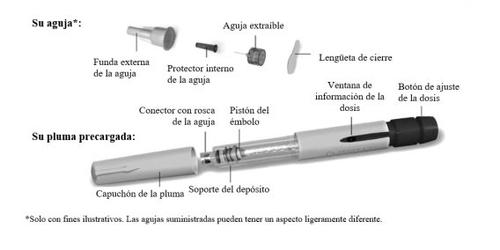
Шаг1 Подготовьте материалы
1.1Подготовьте чистое и ровное место, такое как стол или столешница, в хорошо освещенной зоне. |
|
1.2Вам также понадобится (не включено в упаковку):
| |
1.3Вымойте руки водой и мылом и тщательно высушите их. | |
1.4Аккуратно вытащите предзагруженную ручку Овитрелле из упаковки. | |
Неиспользуйте никаких инструментов, поскольку их использование может повредить ручку. | |
1.5Проверьте, что на ручке указано Овитрелле. 1.6Проверьте дату истечения срока годности на этикетке ручки (Рисунок 3). | |
Неиспользуйте предзагруженную ручку Овитрелле, если она уже истекла или если на ручке не указано Овитрелле. |
Шаг2 Подготовьтесь к инъекции
2.1Снимите колпачок с ручки (Рисунок 4). 2.2Проверьте, что лекарство прозрачно, бесцветно или слегка желтоватое и не содержит частиц. Неиспользуйте предзагруженную ручку, если лекарство изменило цвет или стало мутным, поскольку это может вызвать инфекцию. |
|
Выберите место инъекции: | |
2.3Медицинский работник должен указать вам места инъекции, которые необходимо использовать вокруг области живота (Рисунок 5). 2.4Очистите кожу в месте инъекции ватным шариком, смоченным в спирте. Нетрогайте и не закрывайте кожу, которую только что очистили. |
|
Шаг3 Присоедините иглу
3.1Возьмите новую иглу. Используйте только одноразовые иглы, поставляемые с препаратом. 3.2Проверьте, что внешний колпачок иглы не поврежден. 3.3Держите внешний колпачок иглы крепко. |
|
3.4Проверьте, что язычок крышки внешнего колпачка иглы не поврежден или не ослаблен и что не истекла дата истечения срока годности (Рисунок 6). |
|
3.5Снимите язычок крышки (Рисунок 7). |
Неиспользуйте иглу, если она повреждена или просрочена, или если внешний колпачок иглы или язычок крышки поврежден или ослаблен. Использование просроченных игл или игл с поврежденными язычками крышки или внешними колпачками может вызвать инфекцию. Утилизируйте ее в контейнере для острых предметов и используйте другую иглу, поставляемую с препаратом.
Обратитесь к медицинскому работнику, если у вас есть вопросы.
3.6Закрутите внешний колпачок иглы на резьбовом соединителе иглы предзагруженной ручки Овитрелле до тех пор, пока не почувствуете легкое сопротивление (Рисунок 8). Неперетягивайте иглу при присоединении, поскольку это может затруднить ее удаление после инъекции. |
|
3.7Аккуратно снимите внешний колпачок иглы, потянув его плавно (Рисунок 9). 3.8Отложите его в сторону для использования позже (Рисунок 10). |
|
Невыбрасывайте внешний колпачок иглы, поскольку он предотвратит травмы от укола иглы и инфекции при разделении иглы и предзагруженной ручки. 3.9Держите предзагруженную ручку Овитрелле с иглой, направленной вверх (Рисунок 11). 3.10Аккуратно снимите и утилизируйте внутренний защитный колпачок иглы (Рисунок 12). |
|
Ненадевайте снова внутренний защитный колпачок иглы, поскольку это может вызвать травмы от укола иглы и инфекции.
3.11Тщательно осмотрите кончик иглы на наличие одной или нескольких капель жидкости (Рисунок 13).
|
|
Если вы не наблюдаете никаких капель жидкости на кончике или его окрестностях при использовании новой ручки:
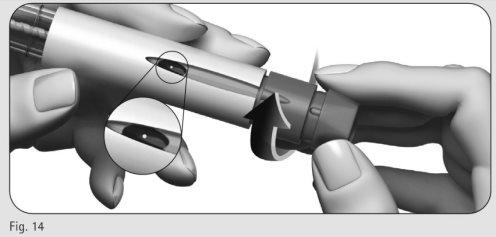
- Аккуратно поверните кнопку дозирования вперед до тех пор, пока не увидите точку (?) в информационном окне дозирования (Рисунок 14).
- Вы можете повернуть кнопку дозирования назад, если вы переместили ее слишком далеко от точки (?).
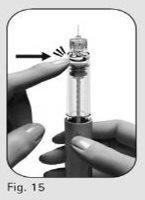
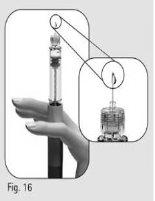
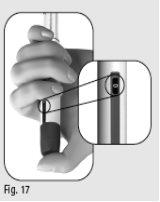
- Держите ручку с иглой, направленной вверх.
- Аккуратно постучите по держателю резервуара (Рисунок 15).
- Полностью нажмите кнопку дозирования. На кончике иглы появится капля жидкости (Рисунок 16)*.
- Проверьте, что информационное окно дозирования показывает «0» (Рисунок 17).
*Примечание: Если вы не наблюдаете никакой жидкости, вы можете начать заново с шага 1 (в этом разделе) только один раз. Если снова не появляется капля жидкости, обратитесь к медицинскому работнику.
Шаг4 Выберите дозу 250
4.1Аккуратно поверните кнопку дозирования впереддо тех пор, пока в информационном окне дозирования не появится «250». | |
Ненажимайте и не тяните кнопку дозирования при повороте. |
|
4.2Проверьте, что информационное окно дозированияпоказывает «250»(Рисунок 19) перед продолжением с шагом 5 ниже. Обратитесь к медицинскому работнику, если вам нужна помощь. |
|
Шаг5 Введите дозу
Важно:вводите дозу так, как показал вам медицинский работник.
5.1Медленно вставьте всю иглу в кожу (Рисунок 20). |
|
5.2Поместите большой палец в центр кнопки дозирования. Медленно и полностью нажмите кнопку дозированияи держите ее нажатой, чтобы полностью ввести инъекцию (Рисунок 21). |
|
5.3Держите кнопку дозирования нажатой не менее 5 секунд перед удалением иглы из кожи (Рисунок 22).
|
|
|
Неотпускайте кнопку дозирования до тех пор, пока не удалите иглу из кожи.
Шаг6 Удалите иглу после инъекции
6.1Поместите внешний колпачок иглы на ровную поверхность. |
|
6.2Держите предзагруженную ручку Овитрелле крепко одной рукой и вставьте иглу в внешний колпачок иглы (Рисунок 24). 6.3Продолжайте толкать иглу в колпачок против твердой поверхности до тех пор, пока не услышите щелчок («клик») (Рисунок 25). 6.4Держите внешний колпачок иглы и поверните иглу в противоположном направлении (Рисунок 26). 6.5Утилизируйте использованную иглу безопасно в контейнере для острых предметов (Рисунок 27). Обращайтесь с иглой осторожно, чтобы избежать травмы. Неповторно используйте и не делитесь никакой использованной иглой с другими людьми. |
|
Шаг7 После инъекции
- Проверьте, что инъекция была введена полностью:
|
|
Если информационное окно дозирования показывает «0», вы завершили дозу.
Если информационное окно дозирования непоказывает «0», обратитесь к медицинскому работнику.
Непытайтесь ввести инъекцию повторно.
Шаг8 Утилизируйте предзагруженную ручку Овитрелле
Важно:Предзагруженная ручка Овитрелле и иглы, поставляемые с препаратом, предназначены для одноразового использования.
|
Обратитесь к медицинскому работнику, если у вас есть вопросы.
Дата последнего пересмотра этих инструкций по применению: 05/2025.
- Страна регистрации
- Активное вещество
- Требуется рецептДа
- Производитель
- Информация носит справочный характер и не является медицинской рекомендацией. Перед приемом любых препаратов проконсультируйтесь с врачом. Oladoctor не несет ответственности за медицинские решения, принятые на основе этого контента.
- Аналоги ОВИТРЕЛЛЕ 250 микрограмм раствор для инъекций в предзаполненной шприц-ручкеФорма выпуска: ИНЪЕКЦИОННЫЙ РАСТВОР, 150 МЕ/ 0,25 мл (11 микрограмм/ 0,25 мл)Активное вещество: фоллитропина альфаПроизводитель: Gedeon Richter Plc.Требуется рецептФорма выпуска: ИНЪЕКЦИОННЫЙ РАСТВОР, 150 МЕ/ 0,25 мл (11 микрограмм/ 0,25 мл)Активное вещество: фоллитропина альфаПроизводитель: Gedeon Richter Plc.Требуется рецептФорма выпуска: ИНЪЕКЦИОННЫЙ РАСТВОР, 150 МЕ/0,25 мл (11 микрограмм/0,25 мл)Активное вещество: фоллитропина альфаПроизводитель: Gedeon Richter Plc.Требуется рецепт
Аналоги ОВИТРЕЛЛЕ 250 микрограмм раствор для инъекций в предзаполненной шприц-ручке в других странах
Лучшие аналоги с тем же действующим веществом и терапевтическим эффектом.
Аналог ОВИТРЕЛЛЕ 250 микрограмм раствор для инъекций в предзаполненной шприц-ручке в Ukraine
Врачи онлайн по ОВИТРЕЛЛЕ 250 микрограмм раствор для инъекций в предзаполненной шприц-ручке
Консультация по дозировке, побочным эффектам, взаимодействиям, противопоказаниям и продлению рецепта на ОВИТРЕЛЛЕ 250 микрограмм раствор для инъекций в предзаполненной шприц-ручке – по решению врача и с учетом местных правил.















